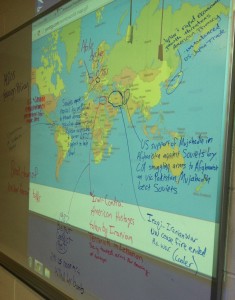Hey, I just got back from the OAH last week also, which had two consequences: returning to campus invigorated with a renewed willingness to experiment BUT having had very little prep time before Monday morning’s classes. So I turned to something I could pull off without a lot of prior work, to keep it from being entirely a cop-out day. I decided the purpose was to turn my students in both classes back to the textbook’s assigned reading (since they sometimes need a refresher on those expectations and skills at this point in the semester, let’s be honest). And I kept it low-tech; I literally copied the chapters & chunked them up into enough sections for each person to have one. Tools needed – just a working copy machine, and whiteboard with a handful of markers.
Example #1 – 200-Level Course on US Since 1945 – 2 chapters on the 1980s, one domestic and one foreign policy. Session goals: Review chapter content, strengthening ability to synthesize & connect. Format: Assembling a puzzle, in which everyone has one piece.
1) Each student got a single page (handed out in page order), which required them to check with neighbors on both sides to make sense of it.
2) Opportunity to read/study/discuss
3) Domestic chapter group was looking for evidence to answer this question: Was there a Reagan Revolution? I asked them to identify continuity AND change on their page and add example of both to lists on the board.
4) Foreign policy chapter group’s assignment was to create a global “weather map” of 1980s hotspots / Cold War. I pulled up a world map image (just by Googling) & projected it onto the whiteboard (I know, it shows 2014 boundaries… I’m sure I could have dug up a 1980s version with a little better searching). Students located the trouble spots mentioned on their page, circled them, and annotated the map with a short description and assigned it a “temperature.” 
Once everything was on the board, we held a class wrap-up discussion – looking for patterns, commenting on our findings. Why it works: everyone had something to contribute, everyone’s piece was equally important and essential to the puzzle. I noticed a high level of participation and engagement.
Example #2 – Survey course – a chapter on the rise of conservatism 1968-1992. Session goals: close reading for argument (we’ve been talking about creating thesis statements & I noticed it was a big bottleneck in their recent papers).
The criteria we’re using is adapted from Mary Rampolla, A Pocket Guide to Writing in History.
 1) Access pre-knowledge, stimulate inquiry (give a reason to read). We began by brainstorming a list of legacies of the 1960s. Then I divided the whiteboard into two large sections: Keeping the 1960s going (‘the beat goes on’) vs. Trying to roll back/contain the 1960s.
1) Access pre-knowledge, stimulate inquiry (give a reason to read). We began by brainstorming a list of legacies of the 1960s. Then I divided the whiteboard into two large sections: Keeping the 1960s going (‘the beat goes on’) vs. Trying to roll back/contain the 1960s.
2) Instructions were to read the section closely and with pen in hand. Mark places where the textbook authors provide facts, and where they seem to advance an interpretation or make an argument. I asked students to identify something that meets our criteria for a thesis statement? (Here we paused for a short full-class reflection and discussion of a couple of examples that did or did not meet the criteria)
3) Next, students taught their section to a neighbor, checking for understanding (took about 10 minutes for both partners to teach and listen)
4) Next, I asked them to evaluate their section, and as in the other class, to see if they could add something to both sides of the board.
5) We ended with a large group discussion – look for patterns; is it balanced? Where’s the preponderance? What does that tell us about the textbook’s interpretation?
Why it works: while it reinforces the importance of textbook reading, it also helps students interrogate the text as constructed version of the past, subject to criticism and revision. I found it helped them slow down to provide only a small piece and spend all class on it. This gives each student something to share with another as the expert, and something to learn from someone else. It contributes to a group understanding, and thus to the notion that history is about consensus-building. And it’s open-ended (I had no predetermined answer & was just as interested as they were to see what the answers were).
Have you found “chunking the chapter” helpful in your classes, or done something similar that also worked (or didn’t)? I’d love to hear in the comments.



Wow! I’m always trying to get my students involved, who are reluctant to speak out in class. This is a great way to get each student involved! Thanks for sharing!!